八年级下册Unit 8 Our Clothes Topic 2 Section B课件
- 格式:ppt
- 大小:9.10 MB
- 文档页数:25
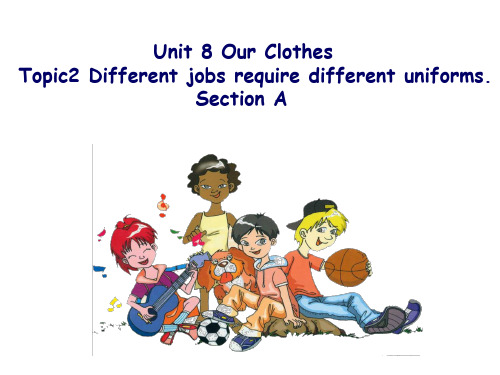

Unit 8 Our Clothes Topic2 We can design our own uniforms.Section A【学习目标】1.学习由疑问词引导的宾语从句。
2.学习句型It’s + adj. + that…和It’s + adj. + (for sb.) to do sth.。
3.谈论制服。
【学习重难点】1.熟练掌握由疑问词引导的宾语从句的语序。
2.能根据对话简单地写出关于穿着制服的重要性的短文【学习过程】一、课前预习(一)从对话中找出下列短语并背会。
1.为你们做校服make uniforms for you 2.穿我自己的衣服wear my own clothes3.穿在身上看着很丑look ugly on sb.4.依赖,取决于depend on5.设计我们的校服design our uniforms 6.独自;单独by oneself7.展现良好的风纪show good discipline(二)从对话中找出下列短语并背会1.采访一名女警察interview a policewoman 2.穿便服wear plain alothes3.执行特殊的任务carry out special tasks 4.有麻烦in trouble5.阻止某人做坏事stop sb.from doing sth.二、知识精讲1.It's true that suitable uniforms can show good discipline.译:____________________________点拨:本句是一个由_______作形式主语的复合句,真正的主语是______________,其结构为:It is +adj.+that从句。
练习:人们穿不同的衣服是很有必要的。
It is ____________ _______ people wear different clothes.2.Can you tell me what Miss Wang says? 译:___________________________________ 点拨:本句为含有特殊疑问词what引导的宾语从句的复合句。
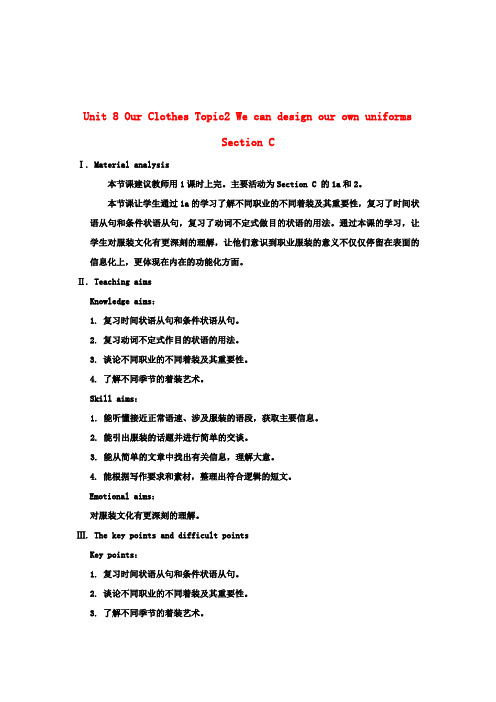
Unit 8 Our Clothes Topic2 We can design our own uniformsSection CⅠ. Material analysis本节课建议教师用1课时上完。
主要活动为Section C 的1a和2。
本节课让学生通过1a的学习了解不同职业的不同着装及其重要性,复习了时间状语从句和条件状语从句,复习了动词不定式做目的状语的用法。
通过本课的学习,让学生对服装文化有更深刻的理解,让他们意识到职业服装的意义不仅仅停留在表面的信息化上,更体现在内在的功能化方面。
Ⅱ. Teaching aimsKnowledge aims:1. 复习时间状语从句和条件状语从句。
2. 复习动词不定式作目的状语的用法。
3. 谈论不同职业的不同着装及其重要性。
4. 了解不同季节的着装艺术。
Skill aims:1. 能听懂接近正常语速、涉及服装的语段,获取主要信息。
2. 能引出服装的话题并进行简单的交谈。
3. 能从简单的文章中找出有关信息,理解大意。
4. 能根据写作要求和素材,整理出符合逻辑的短文。
Emotional aims:对服装文化有更深刻的理解。
Ⅲ. The key points and difficult pointsKey points:1. 复习时间状语从句和条件状语从句。
2. 谈论不同职业的不同着装及其重要性。
3. 了解不同季节的着装艺术。
Difficult points:1. 学习运用功能句正确地阐述穿着职业装的目的。
2. 根据要求,运用本节知识重点整理出符合逻辑的短文。
Ⅳ. Learning strategies写作时要有鲜明的观点才能保证文章脉络的清晰。
Ⅴ. Teaching aidsComputer multimedia projector; the pictures of an official, boots, and the four seasons.Ⅵ. Teaching proceduresⅦ. Blackboard design。
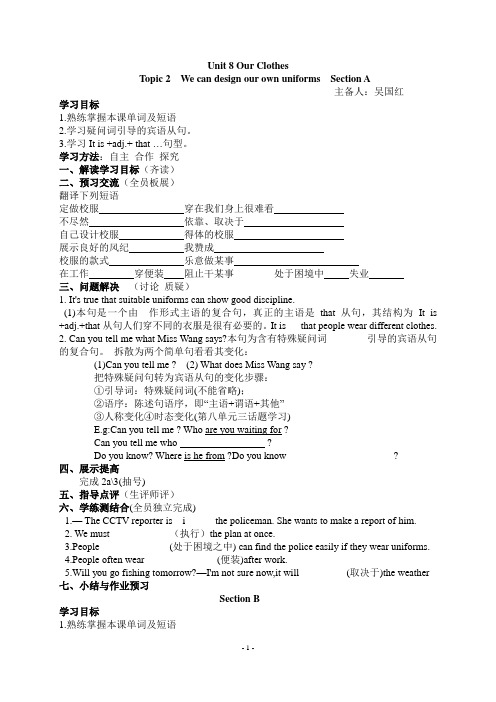
Unit 8 Our ClothesTopic 2 We can design our own uniforms Section A主备人:吴国红学习目标1.熟练掌握本课单词及短语2.学习疑问词引导的宾语从句。
3.学习It is +adj.+ that …句型。
学习方法:自主合作探究一、解读学习目标(齐读)二、预习交流(全员板展)翻译下列短语定做校服______穿在我们身上很难看不尽然______ 依靠、取决于___自己设计校服得体的校服______展示良好的风纪我赞成______校服的款式乐意做某事_____在工作穿便装阻止干某事________处于困境中失业三、问题解决(讨论质疑)1. It's true that suitable uniforms can show good discipline.(1)本句是一个由__作形式主语的复合句,真正的主语是that从句,其结构为It is +adj.+that从句人们穿不同的衣服是很有必要的。
It is___that people wear different clothes.2. Can you tell me what Miss Wang says?本句为含有特殊疑问词________引导的宾语从句的复合句。
拆散为两个简单句看看其变化:(1)Can you tell me ? (2) What does Miss Wang say ?把特殊疑问句转为宾语从句的变化步骤:①引导词:特殊疑问词(不能省略);②语序:陈述句语序,即“主语+谓语+其他”③人称变化④时态变化(第八单元三话题学习)E.g:Can you tell me ? Who are you waiting for ?Can you tell me who _________________ ?Do you know? Where is he from ?Do you know _____________________?四、展示提高完成2a\3(抽号)五、指导点评(生评师评)六、学练测结合(全员独立完成)1.— The CCTV reporter is i______the policeman. She wants to make a report of him.2. We must _____ _____ (执行)the plan at once.3.People _____ ________(处于困境之中) can find the police easily if they wear uniforms.4.People often wear _______ ______ (便装)after work.5.Will you go fishing tomorrow?—I'm not sure now,it will ____ ____ (取决于)the weather七、小结与作业预习Section B学习目标1.熟练掌握本课单词及短语2. .学习It is +adj. (for sb.) to do sth. 句型。
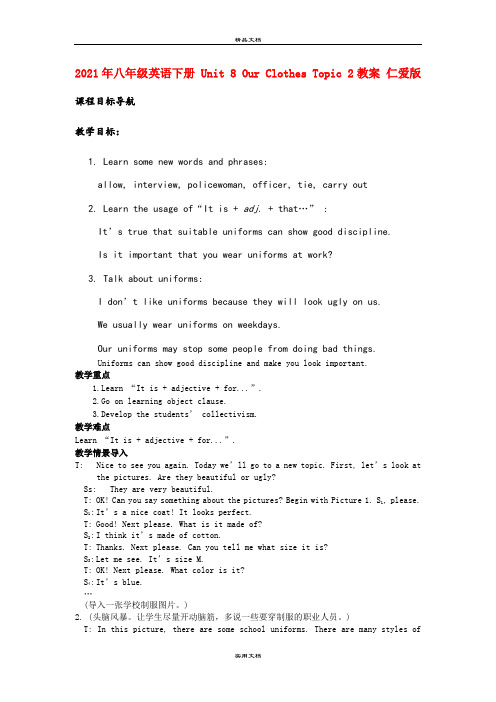
2021年八年级英语下册 Unit 8 Our Clothes Topic 2教案仁爱版课程目标导航教学目标:1. Learn some new words and phrases:allow, interview, policewoman, officer, tie, carry out2. Learn the usage of“It is + adj. + that…” :It’s true that suitable uniforms can show good discipline.Is it important that you wear uniforms at work?3. Talk about uniforms:I don’t like uniforms because they will look ugly on us.We usually wear uniforms on weekdays.Our uniforms may stop some people from doing bad things.Uniforms can show good discipline and make you look important.教学重点1.Learn “It is + adjective + for...”.2.Go on learning object clause.3.Develop the students’ collectivism.教学难点Learn “It is + adjective + for...”.教学情景导入T: N ice to see you again. Today we’ll go to a new topic. First, let’s look at the pictures. Are they beautiful or ugly?Ss: They are very beautiful.T: OK! Can you say something about the pictures? Begin with Picture 1. S1, please. S1: It’s a nice coat! It looks perfect.T: Good! Next please. What is it made of?S2: I think it’s made of cotton.T: Thanks. Next please. Can you tell me what size it is?S3: Let me see. It’s size M.T: OK! Next please. What color is it?S4: It’s blue.…(导入一张学校制服图片。
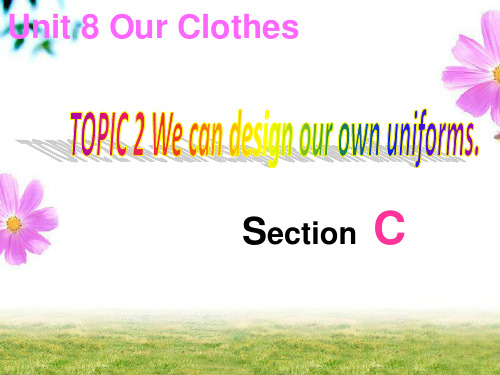
Unit8 Our ClothesTopic2 We can design our uniforms.重点句子Section A1.I like to wear my own clothes because school uniforms will look ugly on us. 我喜欢穿自己的衣服,因为我们穿了校服看起来很丑。
look ugly on us意为:穿在我们身上看起来很丑2.It's true that suitable uniforms can show good discipline. 得体的校服能展示出良好的纪律,确实是这样的。
(1)本句是一个it作形式主语的复合句,真正的主语是that从句,其结构为It is+adj.+that 从句。
类似的用法还有:It is important/necessary/well-known/impossible/possible/wonderful/suitable that…,意为“……是重要的/必要的/众所周知的/不可能的/可能的/极好的/合适的”。
如:It is necessary that people wear different clothes. 人们穿不同的衣服是很有必要的。
It is possible that you can work out the maths problem. 你很有可能会解答出那道数学题。
It is well-known that the earth is round. 众所周知,地球是圆的。
(2)show sth. 意为“展示某物”。
如:Please show your ID card. 请出示你的身份证。
链接:show sb. sth. = show sth. to sb. 意为“把……指给……看;出示”。
如:Jackie showed her the passport. 杰基向她出示了护照。
课题Unit 8 Our Clothes Topic 2 Section C 课型新授课课时 1教学目标Knowledge aims:1. 复习时间状语从句和条件状语从句。
2. 复习动词不定式作目的状语的用法。
3. 谈论不同职业的不同着装及其重要性。
4. 了解不同季节的着装艺术。
Skill aims:1. 能听懂接近正常语速、涉及服装的语段,获取主要信息。
2. 能引出服装的话题并进行简单的交谈。
3. 能从简单的文章中找出有关信息,理解大意。
4. 能根据写作要求和素材,整理出符合逻辑的短文。
Emotional aims:对服装文化有更深刻的理解。
教学重点难点Key points:1. 复习时间状语从句和条件状语从句。
2. 谈论不同职业的不同着装及其重要性。
3. 了解不同季节的着装艺术。
Difficult points:1. 学习运用功能句正确地阐述穿着职业装的目的。
2. 根据要求,运用本节知识重点整理出符合逻辑的短文。
教学准备多媒体教学过程1. Greet students and make them ready for learning.2. The teacher shows the pictures of 2 in Section B. Let students make sentences with the structures It’s + adj. + (for sb. ) to do sth. and It’s + adj. + that …3. The teacher shows the pictures of 1a in Section B and the key words on the screen. Let students act out the four conversations with Could you tell me…? and You should/ have to…4. The teacher presents some sentences about dressing. Let students judgewhether they are suitable or not. If not, let students correct them orally. For example:(1) When I am at home, I should wear a business suit.(2) If I go to a formal party, I should wear jeans.(3) When I am playing basketball, I should wear leather shoes.(4) When we have P.E. classes, we should wear sports shoes.5. The teacher summarizes and leads to 1a: It’s very important to wear suitable clothes on every occasion in our daily life, or in our everyday life. Some people have to wear their uniforms when they are at work. Let’s learn some of them.1. The teacher lets students look at Picture 1 of 1a and adds a pictureof officials. Let students discuss the jobs of the people in the pictures with their partner. Teach the words firefighter, heat and ceiling byintroducing the firefighter in the picture. Teach the words soldier, official, officer and patients by showing their pictures. Teach the word airport by explaining that the pilot works in the airport. Teach the words reason and spread by showing their Chinese meanings.2. The teacher asks students to observe the pictures again and discuss whatfunctions of their uniforms are.3. The teacher lets two or three students speak out their opinions.4. The teacher asks students to skim the passage and compare their opinionswith the writer’s.5. The teacher asks students to read the passage again and answer thequestions: How many kinds of uniforms are there in the text? What are they? Teach the new word text.6. The teacher lets two or three students tell their answers.1. The teacher plays the recording sentence by sentence.2. The teacher plays the recording without stopping.3. The teacher asks students to complete the table of 1b.4. The teacher asks two students to tell the answers. Remind them to pay attention to the usage of infinitives (to +v.).5. The teacher lets students find out the object clauses, adverbial clausesof time and condition as well as difficult points. Solve the difficult points together with the students.(1) Firefighters wear special coats and helmets to protect themselvesfrom heat and falling ceilings.(2) When we see airline pilots wearing uniforms at the airport, we believe that they know how tofly the plane.(3) If we have a car accident on the street and we see a police officerin uniform, we know we can get help from him or her.6. The teacher lets students prepare to retell the passage with the help of 1b within their groups.1. The teacher lets students discuss with their group members whether students should wear uniforms at school. Allow them to have their own opinions. Teach the new word opinion and the phrase in one’s opinion.2. The teacher lets the representative of each group report their opinions.3. The teacher lets the students write a passage about the opinions of theirown groups.4. The teacher evaluates their reports. And stress the advantage andimportance of dressing school uniforms.5. The teacher asks students to learn the new words in the brackets of3a by themselves with the help of the similar words. Teach the newwords boot and casual clothes by showing the pictures of them.(1) great → greatlybeautiful → beautifully(2) north +ern → northernsouth + ern → southerneast + ern → easternwest+ ern → western6. The teacher lets students skimthe passage of 3a and know about the generalideas. Then let the choose the correct words to complete the passage.7. The teacher lets two students report their answers.1. The teacher asks the students to read 3a again and fill in the tableof 3b.2. The teacher lets two students tell the answers.3. The teacher lets students work in pairs. Let them survey their partner’s favorite clothes in different seasons and complete the table.Season Clothesspringsummerfallwinter4. The teacher lets students report the result of the survey.5. The teacher guides students to write a passage according to their report.6. The teacher lets two students write down their passages on the blackboard.Then revise them together with the students.7. The teacher shows the summary of this section to the students.8. The teacher assigns homework:(1) Review the summary after class.(2) Write a passage about your family’s job and their uniforms.(3) Preview section D.作业布置完成同步练习课堂总结Students learn a lot about the importance of uniforms. Many of them didn’t like wearing the school uniforms before, but now they know it’s necessary for them to wear the school uniforms. The teacher may design more sentences or draw some pictures about dressing suiting different jobs, seasons, occasions and so on, let students judge whether they are suitable or not.。